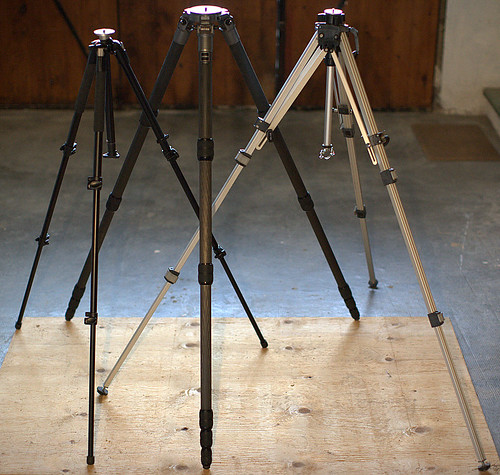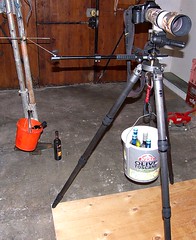Tentatively Technical Testing of Three Tall Tripods
Try telling the title ten times...
Well, I'm in the market for a new tripod. Maybe not a new tripod, maybe just a new arrangement for my existing one(s), but I've been looking for a while. I even borrowed a Manfrotto from my friend Jean-Marc, and on switching my camera from one tripod to the other, I could feel there was a marked difference, but wanted to quantify the behaviour of the tripods in a more objective way.
Tripod manufacturers rate their tripods according to weight, but rigidity is never quantified formally.

The "perturbations" affecting the stability of the camera can be decomposed in two forces, a straight force and a torque. The straight force will be the weight of the equipment (camera, lens, tripod head, tripod itself, and any accessories affixed to the tripod), plus any force transmitted by the photographer's hands to the camera. If there is a strong wind, the action of that wind will exert a sideways force onto the equipment, resulting in a torque transmitted to the tripod head. The photographer's hands are also very likely to exert some torque on the equipment.
To check the rigidity of the tripods, I used the following method:
- The tripod is standing on a flat surface (the floor of my garage, or a sheet of plywood resting on the garage floor, read further).
- A rigid rod of known length is fastened to the tripod platform.
- A known force is exerted at the end of the rod, resulting in a known torque.
- A tripod head is mounted on top of the rod, above the center of the tripod (almost as normal).
- The camera is mounted on the tripod head, with a 400mm lens, aiming horizontally at a board at a known distance.
- The displacement angle is measured by measuring the distance "traveled" by the aiming spot on the board when the torque is released.
The tripods I tested are the following:
- Gitzo G1548GT (not made anymore, I purchased it together with a Wimberley gimbal head to hold a 600mm f/4 lens that weight over 4kg, the current product is the GT5560)
- Manfrotto 190CX lent by Jean-Marc. I took it for a small mountaineering excursion and love the low weight of that tripod.
- Slik (model unknown). I've had this tripod for over twenty years. At the time I purchased it, that's about the only tripod that was available and within my budget. I upgraded from a Velbon at the time. I love the versatility of that tripod.
The photo shows the setup to measure the displacement with a torque along the horizontal axis (the lens will "nod" up and down):

A similar setup is used to measure the displacement with a torque along the vertical axis (the lens will swing left to right):

The main difference with the one above is the addition of a pulley so that the weight will "pull" on the rod horizontally.
I found that when there is very little weight on the tripod, the feet tended to slide on the smooth floor, hence the addition of the plywood sheet.
Results:
1 Horizontal torque - 5Nm.
2 Vertical torque - 5Nm.
For those not familiar with the metric system, to generate a torque of 5Nm, I suspended a mass of just over two pounds (1 kilogram) at the end of a rigid rod of 50 cm (about 2 feet). This gives us an horizontal torque.
To get the vertical torque, I simply ran the suspention wire through a pulley to change the direction of the force.
To give you an idea of the movements observed, if the "target" is situated 6 meters away (that's about 20 feet, or five yards), a shift of 1 degree will result in a sideways move of 10cm (about 4 inches).
About the equipment used.
One important item I have to add is the weight of the gear that was added to the tripod. The camera and lens (400mm f/5.6, so I could measure the movement with a 2mm precision 6 meters away) were supported by a Manfrotto 322RC2 pistol-grip ballhead, and the rod was actually an extended flash bracket Manfrotto 233B. The weight supported by the tripod was 3.75 kg (about 7 pounds), to be added to the "stabilizing weight" suspended under the head.
Conclusion:
I still haven't found an ideal tripod. I like the Manfrotto for it light weight, but it lacks flexibility compared to the slick. I'm eager to try a swiveling column (like the Gitzo GT2531EX)...
Well, I'm in the market for a new tripod. Maybe not a new tripod, maybe just a new arrangement for my existing one(s), but I've been looking for a while. I even borrowed a Manfrotto from my friend Jean-Marc, and on switching my camera from one tripod to the other, I could feel there was a marked difference, but wanted to quantify the behaviour of the tripods in a more objective way.
Tripod manufacturers rate their tripods according to weight, but rigidity is never quantified formally.

The "perturbations" affecting the stability of the camera can be decomposed in two forces, a straight force and a torque. The straight force will be the weight of the equipment (camera, lens, tripod head, tripod itself, and any accessories affixed to the tripod), plus any force transmitted by the photographer's hands to the camera. If there is a strong wind, the action of that wind will exert a sideways force onto the equipment, resulting in a torque transmitted to the tripod head. The photographer's hands are also very likely to exert some torque on the equipment.
To check the rigidity of the tripods, I used the following method:
- The tripod is standing on a flat surface (the floor of my garage, or a sheet of plywood resting on the garage floor, read further).
- A rigid rod of known length is fastened to the tripod platform.
- A known force is exerted at the end of the rod, resulting in a known torque.
- A tripod head is mounted on top of the rod, above the center of the tripod (almost as normal).
- The camera is mounted on the tripod head, with a 400mm lens, aiming horizontally at a board at a known distance.
- The displacement angle is measured by measuring the distance "traveled" by the aiming spot on the board when the torque is released.
The tripods I tested are the following:
- Gitzo G1548GT (not made anymore, I purchased it together with a Wimberley gimbal head to hold a 600mm f/4 lens that weight over 4kg, the current product is the GT5560)
- Manfrotto 190CX lent by Jean-Marc. I took it for a small mountaineering excursion and love the low weight of that tripod.
- Slik (model unknown). I've had this tripod for over twenty years. At the time I purchased it, that's about the only tripod that was available and within my budget. I upgraded from a Velbon at the time. I love the versatility of that tripod.
The photo shows the setup to measure the displacement with a torque along the horizontal axis (the lens will "nod" up and down):

A similar setup is used to measure the displacement with a torque along the vertical axis (the lens will swing left to right):

The main difference with the one above is the addition of a pulley so that the weight will "pull" on the rod horizontally.
I found that when there is very little weight on the tripod, the feet tended to slide on the smooth floor, hence the addition of the plywood sheet.
Results:
1 Horizontal torque - 5Nm.
| Tripod | Stabilizing weight | Movement |
| Gitzo | 0 kg | 0.24 degrees |
| Gitzo | 8.7 kg | 0.24 degrees |
| Manfrotto | 0 kg | 0.52 degrees |
| Manfrotto | 4.7 kg | 0.52 degrees |
| Slick | 0 kg | 0.86 degrees |
| Slick | 4.7 kg | 0.67 degrees |
2 Vertical torque - 5Nm.
| Tripod | Stabilizing weight | Movement |
| Gitzo | 0 kg | 0.33 degrees |
| Gitzo | 8.7 kg | 0.33 degrees |
| Manfrotto | 1 kg | 1.9 degrees |
| Manfrotto | 2 kg | 1.6 degrees |
| Manfrotto | 4.7 kg | 1.5 degrees |
| Slick | 1 kg | 4.8 degrees |
| Slick | 4.7 kg | 3.2 degrees |
For those not familiar with the metric system, to generate a torque of 5Nm, I suspended a mass of just over two pounds (1 kilogram) at the end of a rigid rod of 50 cm (about 2 feet). This gives us an horizontal torque.
To get the vertical torque, I simply ran the suspention wire through a pulley to change the direction of the force.
To give you an idea of the movements observed, if the "target" is situated 6 meters away (that's about 20 feet, or five yards), a shift of 1 degree will result in a sideways move of 10cm (about 4 inches).
About the equipment used.
One important item I have to add is the weight of the gear that was added to the tripod. The camera and lens (400mm f/5.6, so I could measure the movement with a 2mm precision 6 meters away) were supported by a Manfrotto 322RC2 pistol-grip ballhead, and the rod was actually an extended flash bracket Manfrotto 233B. The weight supported by the tripod was 3.75 kg (about 7 pounds), to be added to the "stabilizing weight" suspended under the head.
Conclusion:
I still haven't found an ideal tripod. I like the Manfrotto for it light weight, but it lacks flexibility compared to the slick. I'm eager to try a swiveling column (like the Gitzo GT2531EX)...
Labels: Photo equipment, Tripod, Tripod test

0 Comments:
Post a Comment
<< Home